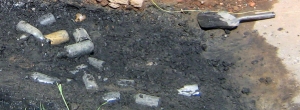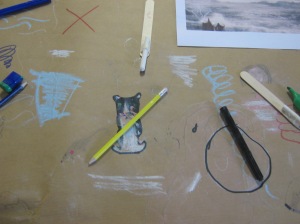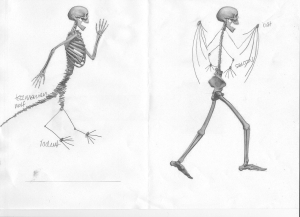
Can you dig it?
Who’d have thought it? Whitworth Park, the park situated down the road next to the Whitworth Art Gallery, turns out to be a fascinating relic from a bygone era! I am ashamed to say that I have only really glanced at the park in passing. That is, however, until last week.
If you happened to visit the park between 1st and 12th July, you may have noticed that there was something afoot! Amongst the resident sun-bathers, joggers and dog walkers, you may have spotted quite a few cheerful-looking individuals wearing high-vis jackets, wondering around the park with tools, sitting under trees (apparently doing some washing up?), or digging holes in the ground: these are The Archaeologists!

Mel Giles and Ruth Colton on site
As part of the Whitworth Park Community Archaeology and History project (for a reminder of our previous involvement, check out this post about the 2011 season), a team of archaeologists from the University of Manchester have been carrying out a study of Whitworth Park. On the 8th and 9th July, I had the pleasure of spending a (sweltering) day in the park when two local schools came to visit the site, and in what follows, I will endeavor to pass on some of what I learned.
You may ask what a group of archaeologists was doing digging around in the park when there are surely much more exciting, exotic places to be working. Well, not only has the unusually summery weather given things a rather tropical feel, but it also turns out that beneath the surface, the park holds many clues about its own history, both physical – the various structures and features of the park – and social – the individuals and groups who visited the park.
While the park’s boundaries and acreage (18 acres!) have remained largely unchanged since it opened in 1890, the structure and features of the space have. So if, like me, you have little knowledge about the park’s history, you may be surprised to learn that it had its own lake! In 1927, the lake was turned into a children’s paddling pool, which was itself subsequently filled in and levelled. If you visit the park today, you will find absolutely no evidence to suggest that there was ever a lake in the park. So how do we know that it was really there?
Postcards and maps provide useful clues about the park’s history, revealing that not only was there a lake in the park (with a gigantic fountain!), but there was also an observatory and a bandstand, amongst other things. Although we can learn a certain amount about the park’s history from such evidence, it is only by examining what was ‘ground level’ over 100 years ago, that such features and the intricacies of park life can actually be studied directly.

How to bail out a lake!
Enter the archaeologists!
Here we see ‘archaeology in action’ as a member of the team watches the site manager, Nick Overton, bail out what used to be part of the lake!
However, a close-up of this image reveals that in the dark silty (and rather smelly) goo that was once the bed of the park’s lake is actually littered with bottles; it would seem that the tradition of hurling empty bottles into lakes (or streams, the sea or any body of water) goes way back.

Bottles in silt
Rather than repeat what has already been written, for those of you who want to find out more about how the dig progressed, I recommend the Whitworth Parklife blog posts and storify pages. For a quick summary, Byran’s Ancient Worlds post is also informative. To find out how the day went when year 4 pupils from Medlock Primary school came to visit the site, check out ‘Digging at the Whitworth’ (guest post, written by the Museum’s four work experience students). Likewise, a post about Manchester Academy’s day on site has been written by one of the archaeologists, Ruth, and can be found here.
So what did they find?
Amongst other things, finds from the excavation include discarded bottles, part of a shoe, buttons, broken pipes, bits of pottery, a lead soldier (unfortunately misheard by one of the students as ‘a dead soldier’!), a pencil, a whistle, and part of a dolls eye! For the archaeologists, the items that were discarded as rubbish are just as valuable as those that found their way into the archaeological record by accident since they all provide clues about the park and its users.

Filling in the trenches on Friday
When I visited the site on Friday, the team were packing up all of their kit and filling in the trenches that they had been working on over the previous fortnight (thankfully with the help of a JCB).
If you visit the park now, you will find little evidence to suggest that anything out of the ordinary had been taking place. However, that is not to suggest that the project is over. A short distance down the road, in the (slightly cooler) department laboratories, the archaeologists are still hard at work. By studying the artefacts and the layers of earth in which they were discovered, the archaeologists will be able to shed more light on the park’s history.
Both the finds and the findings from the archaeological excavations in the Whitworth Park will form the basis of an exhibition at the Manchester Museum, opening in May 2014. I will keep you posted with updates as the project progresses, so watch this space but if, in the meantime, you fancy your hand at archaeology or simply want to find out more, you may be interested in the events taking place at the museum as part of the Festival of Archaeology.


























